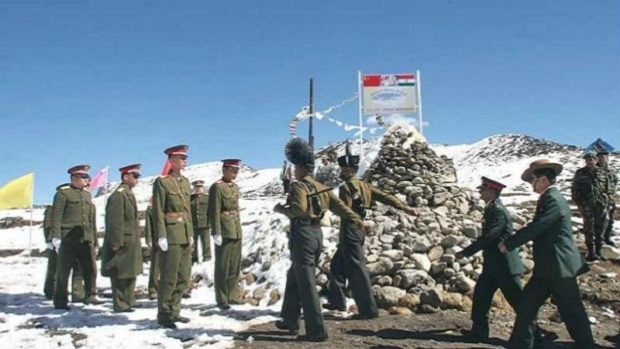
No signs of Indian, Chinese troops backing off as standoff persists in eastern Ladakh
PTI, May 25, 2020, 9:03 AM IST

New Delhi: Indian and Chinese troops appeared heading for a long haul as their tense standoff in the disputed areas of Pangong Tso and Galwan Valley along the Line of Actual Control in eastern Ladakh showed no signs of abating even as efforts to de-escalate the tension through talks continued.
In the midst of the flare-ups, the Indian Army on Sunday, May 24 categorically rejected reports that Indian patrol teams were detained by Chinese troops in Eastern Ladakh in the last few days, but did not provide any details of the current situation in the region.
“There has been no detention of Indian soldiers at the borders. We categorically deny this. It only hurts national interests when media outlets publish unsubstantiated news,” the Army said in a statement.
People familiar with the situation in the region said the two sides were engaged in trying to resolve the dispute, but there was no indication of a positive outcome yet as both the armies continued to bolster their positions in disputed areas of Pangong Tso and Galwan Valley and Demchok.
The Chinese side has particularly strengthened its presence in the Galwan Valley, erecting around 100 tents in the last two weeks and bringing in heavy equipment for the construction of bunkers.
The Indian side has conveyed its strong objection to China pitching tents and bringing in heavy equipment during the meetings between local commanders of the two armies last week.
“There have been reports of multiple incidents of transgressions by Chinese troops in several areas in Eastern Ladakh and soldiers from the two sides were involved in scuffles on at least two occasions,” sources said.
“The sources said the Indian Army has also been increasing its strength in both Pangong Tso lake, Galwan Valley and Demchok. The Indian troops are also resorting to “aggressive patrolling” in several sensitive areas including Demchok and Daulat Beg Oldi,” they said.
The situation in Eastern Ladakh deteriorated after around 250 Chinese and Indian soldiers were engaged in a violent face-off on the evening of May 5 which spilled over to the next day before the two sides agreed to “disengage” following a meeting at the level of local commanders.
Over 100 Indian and Chinese soldiers were injured in the violence.
The incident in Pangong Tso was followed by a similar incident in North Sikkim on May 9.
India on Thursday said that the Chinese military was hindering normal patrolling by its troops and asserted that India has always taken a very responsible approach towards border management.
At a media briefing, External Affairs Ministry Spokesperson Anurag Srivastava also strongly refuted China’s contention that the tension was triggered due to trespassing by Indian forces on the Chinese side.
India’s response came two days after China accused the Indian Army of trespassing into its territory, claiming that it was an “attempt to unilaterally change the status” of the LAC in Sikkim and Ladakh.
On May 5, the Indian and Chinese army personnel clashed with iron rods, sticks, and even resorted to stone-pelting in the Pangong Tso lake area in which soldiers on both sides sustained injuries.
In a separate incident, nearly 150 Indian and Chinese military personnel were engaged in a face-off near Naku La Pass in the Sikkim sector on May 9. At least 10 soldiers from both sides sustained injuries.
The troops of India and China were engaged in a 73-day stand-off in Doklam tri-junction in 2017 which even triggered fears of a war between the two nuclear-armed neighbours.
The India-China border dispute covers the 3,488-km-long LAC. China claims Arunachal Pradesh as part of southern Tibet while India contests it.
Both sides have been asserting that pending the final resolution of the boundary issue, it is necessary to maintain peace and tranquility in the border areas.
China has been critical of India’s reorganization of Jammu and Kashmir, and has particularly criticized New Delhi for making Ladakh a union territory. China lays claim over several parts of Ladakh.
Prime Minister Narendra Modi and Chinese President Xi Jinping held their first informal summit in April 2018 in the Chinese city of Wuhan, months after the Doklam standoff.
In the summit, the two leaders decided to issue “strategic guidance” to their militaries to strengthen communications so that they can build trust and understanding.
Modi and Xi held their second informal summit in Mamallapuram near Chennai in October last year with a focus on further broadening bilateral ties.
Udayavani is now on Telegram. Click here to join our channel and stay updated with the latest news.
Top News

Related Articles More

Strict provisions of law for women’s welfare; marriage not commercial venture: SC

BJP files police complaint against Rahul, seeks FIR under ‘attempt to murder, assault, incitement’

Mid-sea crash: Navy institutes ‘Board of Inquiry’ to establish facts of case

Centre released Rs 47,225 crore to states and UTs under Smart Cities Mission: Tokhan Sahu

Union Home Minister Amit Shah reviews J&K security situation
MUST WATCH
Latest Additions

Bhadravathi: Seven injured in boiler explosion at rice mill

Strict provisions of law for women’s welfare; marriage not commercial venture: SC

Allegation of abuse against K’taka Minister Laxmi: BJP leader C T Ravi booked, taken into custody

Gadag: 2-yo girl dies after being run over by water tanker

Mangaluru Traffic Advisory: Netravathi Bridge repair work to affect vehicle movement
Thanks for visiting Udayavani
You seem to have an Ad Blocker on.
To continue reading, please turn it off or whitelist Udayavani.
















